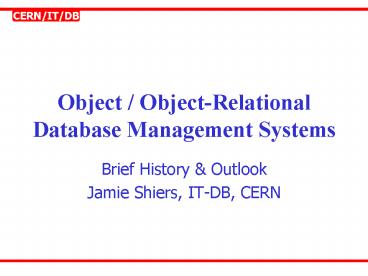Object ObjectRelational Database Management Systems - PowerPoint PPT Presentation
Title:
Object ObjectRelational Database Management Systems
Description:
E.F.Codd: 'A Relational Model of Data for Large Shared Data Banks', CACM 13, 6 ... See http://wwwinfo.cern.ch/db/aboutdbs/papers/SRC-1997-018.pdf ... – PowerPoint PPT presentation
Number of Views:59
Avg rating:3.0/5.0
Title: Object ObjectRelational Database Management Systems
1
Object / Object-Relational Database Management
Systems
- Brief History Outlook
- Jamie Shiers, IT-DB, CERN
2
Overview
- Evolution of Object Object-Relational DBMS
- Status of Market today
- Outlook
3
Definitions
- From Stonebraker Object-Relational DBMSs The
Next Great Wave - Filesystems no query
- RDBMS query, simple data
- ODBMS no (poor) query, complex data
- ORDBMS query complex
- (Picture Akmal Chaudri)
4
RDBMS
- E.F.Codd A Relational Model of Data for Large
Shared Data Banks, CACM 13, 6 (June 1970) pp 377
387 - See http//wwwinfo.cern.ch/db/aboutdbs/papers/SRC-
1997-018.pdf - Led to numerous commercial products Oracle,
SQL/DS, DB-2, SYBASE, Informix, MS SQLServer,
etc. - In use at CERN since early 1980s
5
ODBMS
- Started late 1980s in research projects
- Altaïr ? O2, Objectivity/DB, Ontos,
- Target markets (Cattell) CAD, CASE, CAP,
Scientific/Medical, AI, etc. - Object-Oriented DB Manifesto
- An OO DBMS must satisfy 2 criteria
- It should be a DBMS
- It should be object-oriented
6
ODBMS Speculation
7
ODBMS Reality
- Market much smaller than predicted
- Rationalisation
- but less than in RDBMS market
- O2 presumably now belongs to IBM!
- What happened?
8
Market
- Numerous dinosaur analogies
- After all, IBM invented RDBMS technology and only
now(?) have a competitive RDBMS product - Can lightning strike twice / thrice?
- Predictions of ODBMS market revised down in 1998
timeframe - Original predictions (apparently) included ORDBMS
component - In other words, 1-2B includes Oracles share
9
Technology
- ODBMS initially worked with Smalltalk, C, CO2,
- Mainstream?
- Industry focus is now on Java, XML,
- The latter provided sufficient impetus for
established vendors to enhance their products - See, for example, VLDB papers
10
VLDB Papers
- 1989 complex objects / object modeling
- 1990 performance of OODBs
- 1999 XML Extending SQL with user-defined data
types - O-O, What Have They Done to DB2?
- 2000 A Database Platform for Bioinformatics
- The need for complex data models has now moved
mainstream - The established vendors have seen it coming and
have reacted
11
Impact on ODBMS
- Down-turn of ODBMS market blamed on RDBMS
announcements - e.g. Oracle 8.0, 8i,
- Oracle 9i claims complete object support
according to SQL-99 standard - C binding provides ODMG-like interface for C
programmers with both navigational associative
access
12
ODBMS / RDBMS / ORDBMS
From 1999 RD45 Status report
- RDBMS object extensions
- Can store ADTs
- Methods on server
- Complex Data with Queries
- 8B in 1996
- Likely to become dominant DBMS technology
- Complex Data
- Performance, scalability
- Tight Language Binding
- OQL - SQL3 query subset
- Growth similar to RDBMS in 80s
- 1B market by 2001
100M?
13
Risk AnalysisSummary of Options
- Evaluate C binding to e.g. ORACLE
- Add ESCROW clause to Objectivity contract
- Pursue possibility of source license
- Visit key Objectivity customers
- Produce new requirements list
- Estimate manpower to support Objy in house
- Estimate manpower for clean-sheet solution
- Continue to monitor alternatives
The LCB agrees with the other suggested steps to
mitigate risk, with the addition of trying to
insure that user code in reconstruction and
analysis programs is kept as standards compliant
as possible.
14
Espresso
- Preliminary results from the Espresso
proof-of-concept prototype suggest that a
home-grown ODBMS focussing on HEP needs could be
built with a reasonable amount of manpower,
perhaps some 15 person-years in total. However,
it is far from clear where even such a modest
amount of manpower could come from, particularly
in a period when the overall CERN manpower is
shrinking. A certain amount of manpower could
possibly be found within the collaborations and
at external institutes. However, a core team
responsible for the main developments would most
likely have a significant impact on the viability
of such a project. In the immediate future, there
is essentially no manpower available beyond that
to complete the performance and scalability tests
and write an architectural document. In the
longer term, a home-grown ODBMS remains a
possible fallback solution, although the time to
develop a full product suggests that this will no
longer be true much later than 2002.
15
Oracle C Binding
- Numerous C wrappers to Oracles C interface
exist - With Oracle 9i, a C binding, modelled on JDBC,
comes with the product - Had this existed in 1995, history might well have
been different
16
Oracle 9i studies
- Focus of this workshop
- Well, today tomorrow
- Discussed at last Julys RD45 workshop
- As Oracle 8.2 the number changed but the
features did not - During the Hoffmann Review of LHC Computing
- Activity kicked off after IT Eloise meeting
17
(No Transcript)
18
Eloise Actions
- The possibility of a joint project between
Oracle and CERN should be explored to allow
participation in the Oracle 9i ? test with the
goals of evaluating this product as a potential
fallback solution and providing timely feedback
on physics-style requirements. Non-staff human
resources should be identified such that there is
no impact on current production services for
Oracle and Objectivity.































